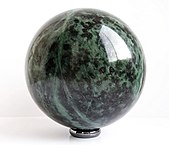Antigorite
| Antigorite | ||
|---|---|---|
Specific gravity 2.5–2.6 | | |
| Optical properties | Biaxial (−) | |
| Refractive index | 1.53–1.575 | |
| Birefringence | δ = 0.005–0.006 | |
Antigorite is a lamellated,
Geologic occurrences
Antigorite is found in low-temperature, high-pressure (or high-deformation) environments, including both extensional and compressional
- + 4H2O + SiO2 →
- + 3CO2 → + + 3H2O[8]
Physical properties
Lamellated antigorite occurs in tough, pleated masses. It is usually dark green in color, but may also be yellowish, gray, brown or black. It has a Mohs scale hardness of 3.5–4 and its
Gemstone properties

Antigorite is used as gemstones or for carvings when it appears pure and translucent, although many crystals have black specks of magnetite suspended within. The gem types of antigorite are Bowenite and Williamsite. Bowenite, known for George T. Bowen from Rhode Island (the variety's type locality), who first analyzed the mineral, is translucent and light to dark green, often mottled with cloudy white patches and darker veining. It is the serpentine most frequently encountered in carving and jewelry, and is the state mineral of Rhode Island, United States. A bowenite cabochon featured as part of the "Our Mineral Heritage Brooch", was presented to U.S. First Lady Mrs. Lady Bird Johnson in 1967. Williamsite is very translucent and has a medium to deep apple-green color. Somewhat resembling jade, Williamsite is often cut into cabochons and beads.
Crystal structure

The magnesian serpentines (antigorite, lizardite, chrysotile) are trioctahedral hydrous phyllosilicates. Their structure is based on 1:1 octahedral-tetrahedral layer structures. Antigorite is monoclinic in the space group Pm.[13] Although the magnesian serpentines have similar compositions, they have significantly different crystallographic structures, which are dependent on how the SiO4 tetrahedra sheets fit in with the octahedral sheets.[14] Antigorite's basic composition has a smaller ratio of octahedral to tetrahedral cations (relative to lizardite and chrysotile),[15] allowing the structure to compensate for the misfit of sheets through periodic flipping of the curved tetrahedra layers, and subsequently their polarity.[16] Polysomes of antigorite are defined by the number of individual tetrahedra (denoted as the value m) which span a wavelength of the direction of curvature.[17] The sheets of tetrahedra allow the platy, fibrous crystals to separate parallel to the 001 (basal) plane, giving antigorite its perfect cleavage.
See also
- Serpentine subgroup
- Serpentinite
- Subduction zone metamorphism – Hydrous minerals of a subducting slab
References
- S2CID 235729616.
- ^ "AMCSD Search Results". rruff.geo.arizona.edu.
- S2CID 55304426.
- S2CID 12878042.
- ^ "Antigorite Mineral Data". webmineral.com.
- .
- .
- ISBN 978-0903056-33-5.
- ^ "Antigorite Mineral Data". webmineral.com.
- ^ "Antigorite gemstone information". www.gemdat.org.
- ISSN 1525-2027.
- .
- S2CID 94811681.
- ISSN 0008-4476.
- ISBN 978-1-5015-0899-8
- ISSN 0008-4476.
- S2CID 129217493.
